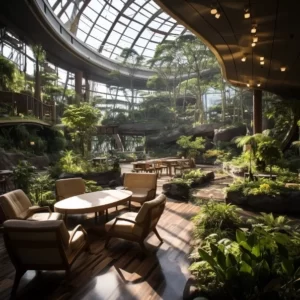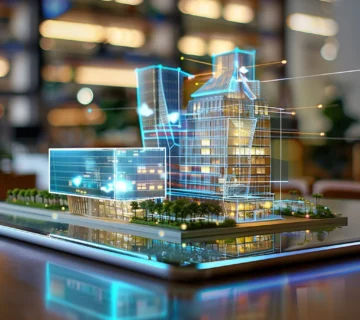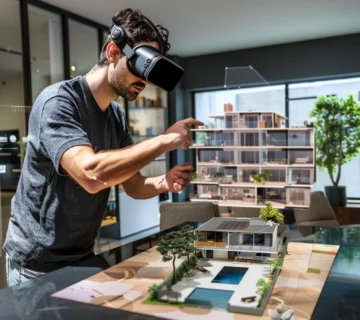5 Top Principles of Sustainable Architecture in 2030
As we step into the future, the concept of sustainable architecture becomes increasingly vital in addressing environmental concerns and creating building architecture that are in harmony with our planet. Sustainable architecture, often referred to as green architecture, focuses on designing structures that minimize their negative impact on the environment while maximizing their efficiency and durability. In this article, we delve into the five top principles of sustainable architecture set to shape the industry by 2030, offering innovative solutions that prioritize both the environment and human well-being.
Sustainable Architecture: Trends and Meaning
Sustainable architecture is a dynamic and evolving field that holds immense significance in the context of modern architecture or futuristic architecture in our changing world. With environmental concerns, resource conservation, and a commitment to a better future at the forefront, sustainable architecture stands as a beacon of hope. In this article, we explore the trends and meaning of sustainability in architecture design, shedding light on its vital role in shaping the built environment and contributing to a greener, more resilient planet.
“Sustainable architecture is a general term that refers to buildings designed to limit humanity’s impact on the environment. An eco-friendly approach to modern-day building encompasses every aspect of the planning and construction process.”[thespruce]
Understanding Sustainable Architecture
At its core, sustainable architecture is about designing and constructing exterior architecture and interior architecture of buildings with a focus on minimizing their negative impact on the environment while enhancing the well-being of their occupants. It’s an approach that considers the full lifecycle of a building, from initial design and construction to operation and eventual deconstruction. Sustainable architecture seeks to create structures that are energy-efficient, resource-conscious, and environmentally responsible.
An exemplary instance of sustainable architecture can be found in The Vertical Forest, in Milan, a pioneering structure that represents a novel approach to architectural biodiversity. This innovative concept goes beyond human-centric design, placing significant emphasis on the interconnectedness between humans and various other living species.
Figure 1: The Vertical Forest, in Milan
5 Trends Shaping Sustainable Architecture
-
Renewable Energy Integration:
Sustainable architecture is increasingly embracing renewable energy sources. Solar panels, wind turbines, and geothermal systems are becoming standard features of sustainable buildings. This trend reflects a commitment to reducing energy consumption and utilizing clean, renewable sources to power structures.
-
Net-Zero Energy Buildings:
The concept of net-zero energy buildings is gaining momentum. These structures generate as much energy as they consume, often through a combination of energy-efficient design, renewable energy systems, and smart building management. This trend aligns with the broader goal of reducing greenhouse gas emissions and lessening the impact of buildings on climate change.
-
Green Building Certifications:
Certifications like LEED (Leadership in Energy and Environmental Design) and BREEAM (Building Research Establishment Environmental Assessment Method) are becoming more widely recognized and sought after. These certifications provide clear standards for sustainable building practices and serve as benchmarks for excellence in green construction.
-
Biophilic Design:
The integration of nature into architectural designs is a growing trend. Biophilic design seeks to connect people with nature by incorporating elements like green roofs, indoor plants, and natural materials. This trend reflects a deeper understanding of the importance of nature in promoting human well-being.

-
Resilient Design:
Resilience in the face of climate change is a critical trend. Sustainable architecture emphasizes building designs that can withstand extreme weather events, natural disasters, and changing environmental conditions. Resilient structures are adaptable and capable of responding to unforeseen challenges.
The Meaning of Sustainable Architecture
Sustainable architecture carries profound meaning in our world. It signifies a commitment to environmental stewardship, resource conservation, and human well-being. It represents an acknowledgment of the pressing need to address climate change, reduce waste, and protect our natural resources.
Sustainable architecture is about more than just constructing eco-friendly buildings; it’s a holistic approach to designing spaces that enrich the lives of their occupants and respect the planet. It embodies the idea that architectural innovation and responsible environmental practices can coexist, resulting in buildings that not only serve their purpose but also contribute to a more sustainable and resilient future.
Sustainable architecture embraces the idea of adaptive reuse and repurposing of existing structures. This trend reduces the need for new construction and the associated use of resources. Old buildings are transformed into vibrant, sustainable spaces, preserving their historic and architectural value.
sustainable architecture is more than a trend; it’s a transformative movement that holds deep meaning. It’s a reflection of our commitment to a better world, where architecture serves as a beacon of hope, guiding us toward a greener, more sustainable future.
-
Energy Efficiency and Passive Design
By 2030, energy efficiency will be at the core of sustainable architecture. Buildings will be designed to maximize natural light and ventilation while minimizing the need for artificial heating and cooling. Passive design principles, such as well-placed windows and insulation, will play a significant role in reducing energy consumption. Renewable energy sources, such as solar panels and wind turbines, will be seamlessly integrated into building designs, ensuring that structures are not only energy-efficient but also capable of generating their power.
-
Sustainable Materials and Green Construction
In the quest for sustainability, the materials used in construction will undergo a significant transformation. By 2030, sustainable architecture will heavily rely on recycled, reclaimed, and low-impact materials. Innovations like engineered wood products and low-impact concrete will become standard, reducing the carbon footprint of construction. Green construction techniques will emphasize minimal waste, efficient use of resources, and eco-friendly building practices. Sustainable architecture will not only prioritize energy-efficient operations but also consider the entire lifecycle of the exterior architecture design, from its initial construction to eventual deconstruction and recycling.
-
Biophilic Design and Healthy Environments
Sustainable architecture in 2030 will place a strong emphasis on biophilic design, which seeks to reconnect people with nature through the built environment. Green spaces, indoor plants, and natural materials will be integrated into building designs to enhance occupants’ physical and mental well-being. Sustainable architecture will focus on creating healthy indoor environments, promoting better air quality, and reducing toxins. The goal is to design spaces that nourish both the human spirit and the environment.
In the sustainable architecture landscape of 2030, biophilic design emerges as a dominant principle, reflecting a profound shift in how we relate to our surroundings. This design approach recognizes the intrinsic connection between humans and nature and seeks to reestablish this bond within the built environment.
A. Green Spaces and Natural Elements:
Biophilic design incorporates green spaces within buildings, such as atriums, rooftop gardens, and vertical gardens. These areas not only provide a visual connection to nature but also offer places of respite and relaxation for building occupants. Natural elements, like flowing water features and rock formations, are integrated into interior spaces to evoke the tranquility of the outdoors.

B. Indoor Plants and Greenery:
Indoor plants play a pivotal role in biophilic design. They introduce nature into indoor settings, purify the air, and create a refreshing ambiance. These living elements promote a sense of well-being and reduce stress, contributing to the physical and mental health of building occupants.
C. Natural Materials and Finishes:
Sustainable architecture in 2030 incorporates a wide array of natural materials and finishes. Wood, stone, and other eco-friendly materials are used to create surfaces and furnishings that resonate with the textures and colors of the natural world. This not only enhances the aesthetics of space but also fosters a sense of connection with the environment.
D. Healthy Indoor Environments:
Air quality and overall indoor environmental quality become paramount concerns in biophilic design. Sustainable architecture places a strong emphasis on promoting clean, healthy air through efficient ventilation and air purification systems. Toxins and pollutants are minimized, ensuring that indoor spaces are conducive to the well-being of their occupants.
E. Nurturing the Human Spirit:
Beyond physical health, biophilic design acknowledges the importance of nourishing the human spirit. Spaces are designed to evoke positive emotional responses, tranquility, and inspiration. The integration of natural elements and greenery creates an environment where people can thrive, fostering creativity, productivity, and overall happiness.
In summary, sustainable architecture in 2030 redefines the way we design and experience the built environment. The principles of biophilic design go beyond aesthetics; they embrace the profound connection between humans and nature, promoting a harmonious and healthful coexistence. By integrating green spaces, natural elements, indoor plants, and eco-friendly materials, sustainable architecture strives to create spaces that not only protect the environment but also nurture the human spirit, enriching the lives of those who inhabit these buildings.
-
Water Conservation and Management
Water scarcity is a growing concern, making efficient water use a paramount principle of sustainable architecture in 2030. Buildings will incorporate advanced water-saving technologies, such as rainwater harvesting and greywater recycling systems. Sustainable landscaping practices will minimize the need for irrigation, and buildings will prioritize water-efficient fixtures and appliances. Sustainable architecture will contribute to a future where water resources are conserved and used wisely.
-
Resilience and Adaptability
In an era of climate change, sustainable architecture in 2030 will focus on creating resilient buildings that can withstand the challenges of an evolving environment. These structures will be adaptable, capable of responding to changing conditions, whether through innovative technologies or flexible designs. Resilience will be a key principle, ensuring that buildings can endure natural disasters, extreme weather events, and other unforeseen challenges, all while minimizing their environmental impact.
conclusion:
In conclusion, the future of sustainable architecture in 2030 is one of innovation, efficiency, and responsibility. As the world grapples with environmental concerns, sustainable architecture stands as a beacon of hope, offering solutions that are not only kind to the planet but also prioritize the well-being of those who inhabit these structures. The principles of energy efficiency, sustainable materials, biophilic design, water conservation, and resilience are set to shape the sustainable architecture of tomorrow, creating a brighter and more sustainable future for all.




